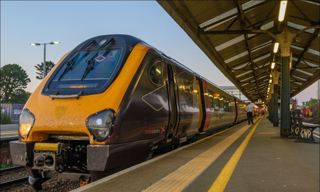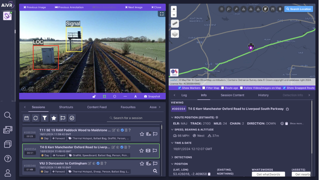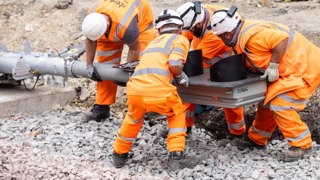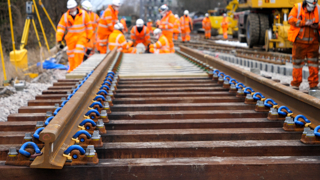Alex Hynes is an ambitious man. Sitting in his office on a rainy Glasgow day, the new ScotRail Alliance Managing Director explains that is why he left the MD’s role at Northern to take on this new position.
Hynes has replaced Phil Verster, who has moved to work on the East West Rail project. Hynes himself has left an operator that was about to benefit from brand new trains and an increase in electrified routes, but one where there were still challenges.
Industrial action blights Northern at the moment, in a row over Driver Only Operation. Electrification has been cancelled on the Windermere branch, and doubts remain over wiring the trans-Pennine route from Manchester to Leeds. Officially it has not been cancelled, but Secretary of State for Transport Chris Grayling said in an interview with the Financial Times on July 21 that it was unlikely the project would happen.
In various speeches at various conferences, Hynes would explain the four major changes that would happen on Northern in 44 months, yet you wonder if - in the background - there was concern over delivery of the major upgrades planned.
From south of the border, Scotland may seem like the perfect railway opportunity. Borders Railway has involved the reversal of a Beeching closure and the reopening of a 30½-mile section of railway. Electrification is ongoing, and will link the country’s two major cities via the quickest route possible. Wires have been strung up in recent years on various commuter routes in and around Glasgow and Lanarkshire, while they are planned for Stirling and Alloa.
Refurbished High Speed Trains are also to be introduced from next year, serving the country’s seven cities and improving the service offering from three-car diesel multiple units to four- and five-car HSTs.
Hitachi is delivering brand new electric multiple units to ScotRail from the summer, while the manufacturer’s Intercity Express Programme (IEP) trains will start serving Scotland from next year for Virgin Trains East Coast.
And yet the railways in Scotland come in for constant criticism. Performance is scrutinised, and delays and failures make front page news in the national press. Social media is quick to jump on any problems.
Scottish Transport Minister Humza Yousaf has made it quite clear that he and his Scottish National Party (SNP) believe Network Rail should be devolved and run by Holyrood, with funding arranged via the Scottish Government. Already Holyrood’s Transport Scotland sets the specification for the ScotRail franchise, with a higher emphasis on quality than Whitehall would otherwise place. Performance north of the border is good, but seemingly that’s not enough for either the politicians or travelling public.
The Scottish railway network is also full of complications. The main line to Aberdeen, for example, has 100mph running under semaphores controlled by signal boxes. There are grand pieces of infrastructure such as the Forth and Tay Bridges; modern, electrified routes in Strathclyde and Ayrshire; and lines that wind through the wilds of the Highlands. No two routes are the same.
The train fleet is quite modern, but is about to be refreshed by brand new Class 385s from Hitachi and 40-year-old HSTs from Great Western Railway (albeit refurbished). Its mid-life Class 170 fleet is to shrink, with trains cascaded to Northern and Southern.
Glasgow Central is one of the top ten busiest stations in Britain, yet Hynes must also manage stations that few people use. Glasgow Queen Street is being remodelled, but remains open. Likewise Edinburgh Waverley.
While industrial action is affecting Northern services, Hynes has joined an operator that has been through those problems. He recognises that problems affected performance figures last year.
For an ambitious man, that’s a lot to contend with. His role also combines both Network Rail and ScotRail, while dealing with Scotland’s operators and stakeholders… and the politicians… and his bosses in London. Yet Hynes is optimistic.
In his office in Glasgow, a short walk from Central station, Hynes explains why he took the job in the first place.
“I never could work for another TOC. Here, I’m getting experiences I never had with Northern. It’s an exciting business plan.”
Of his time at Northern, he says: “We delivered the best ever set of performance and satisfaction results. It was a lot happier place when I left than when I arrived.”
If that was the case, why leave?
“I’m ambitious.”
Hynes acknowledges that politics are never far away in his new job, and he embraces this: “Scotland’s railway is very high profile and pretty political. The media and the stakeholders keep a close eye, but that goes with the territory.”
He tries to think of anywhere else that is held so closely under the microscope, and suggests that only London gets this much scrutiny.
“ScotRail has a higher profile here than a typical TOC does in England and Wales. Everything is magnified here. Scotland has five million people. It has its own Parliament. It has its own media and its own papers. I was told Scotland has more newspapers per person than anywhere else in the world.”
If that sounds like pressure, it is. And yet Hynes describes his first few weeks as “brilliant”. He says he knew the job would be full of challenges, but he likes that. Managing the Alliance is a great thing, he says.
“All the operators are customers of mine. On Day One I rang them and said ‘I’m here, I’m your supplier’. I have met David Horne at Edinburgh Waverley. He said IEPs are coming next year, and it will be the first time two pantographs have been up at 125mph - I need to look at making sure the wires are capable of that.
“Infrastructure is part of the management team here. Next month we have the Edinburgh Festival. Ordinarily the TOC would have its planning team go and talk to Network Rail - in my team meetings we have the same people in the room.”
So if Hynes is in charge of both NR and SR in Scotland, who is Hynes’ boss?
“Nigel Harris jokes that I have three bosses , and perhaps he’s not wrong. I report dually to Network Rail and Abellio.”
Hynes admits that last year was difficult for ScotRail. There were seven days of disruption as industrial action took hold over the planned role of guards on new trains, where Driver Only Operation was being considered. Performance faltered, as did passenger satisfaction (see table, page 49), and Hynes wants to turn that round - fast.
A Head of Performance is now in place, with the task of tracking how the railway is performing. This is done daily, with updates twice a day that Hynes receives directly.
“There is a relentless focus on the day-to-day operations within a ‘one team’ approach,” says Hynes. He explains there is also a Head of Control position, whereas most TOCs and Network Rail have just one person to cover both roles. “I think that has helped on delivery,” says Hynes.
Turning the railway around is key for Hynes. It performs well against certain parts of the UK, but he wants it to be better and to achieve a 92.5% Public Performance Measure Moving Annual Average.
“Detail is necessary,” he says. “It may not be sufficient to get 92.5%, but I want plans. We need to hold people to account. Performance improvement is something I want. There can be no complacency.”
Where can ScotRail improve?
“I think the way we deal with disruption is an Achilles heel. We need to get better, and we need to communicate that to staff.”
Another area he wants to tackle is train cleanliness, while the quality of the major stations is also something Hynes believes the Alliance needs to improve.
“The punctuality is really rather good, but that brings out the needs for other things. If you look at customer satisfaction, it is about train cleanliness. Punctuality and frequency is good, but could be better.”
Hynes has observed that since he moved to Scotland, his passengers and stakeholders are keen to give insight.
“They are very quick to tell people if something is wrong. If ScotRail works then Scotland works. One thing I have noticed is off-peak loadings. The product there is so strong.”
He puts the strong off-peak loadings partly down to the fares structure in Scotland, which is different to the rest of the UK because it’s set by Holyrood. “Peak fares are set by RPI , but here off-peak fares are RPI-1% and they are getting cheaper. Fares are therefore affordable.”
Before he took the role, Hynes travelled over as much of the Scottish network as he could (although he still has parts to cover) to conduct ‘mystery shopping’. He was able to travel unrecognised, learn about what he was about to become master of, and decide where he thought improvements could be made. It was an eye-opener.
“One observation of my mystery shopping was that I noticed there was no opportunity for feedback. Customer service needs to ask for feedback.”
Immediately he has decided to introduce the same system as at Northern, whereby passengers can tweet the vehicle number of the train they are travelling in, and that will be fed to the engineering team to remedy the fault.
“Who are we to judge? The passengers should be the judge,” he says. Even Hynes has done it - the air-conditioning unit on the train he was travelling home on failed, and so he tweeted the number.
For feedback, Hynes says social media is very important: “The fact that ScotRail and I are on Twitter helps us. For our customers, we are there to see. There are also internal social networks, and we are developing networks which will be able to praise staff.”
In terms of the Network Rail aspect of the business, he highlights the remoteness of some of the employees.
“You have to remember on infrastructure, we have some workforce members in hard-to-reach places. There is a lot of lone working. These people don’t have team meetings, so these networks will help.”
Hynes says of the staff he now leads: “The pride and passion is awesome. We need to tap into that and harness it. We need to develop that culture and listen to the people who know the job.”
Hynes lives in Edinburgh, and commutes on the Edinburgh to Glasgow route: “I travel Standard Class. Restoring customer satisfaction, for me, that is urgent and critical.” He jokes that he gets recognised now.
And he wants improvements: “We need to consign last year to the bin. Abellio will judge success - getting improvements on the National Rail Passenger Survey is important.”
Hynes has only been in the job for a few weeks, and is therefore still refining how he carries out his role, but he says that one key element is getting out to meet people. This is something he did at Northern, and something he wants to achieve again.
“Every Friday is kept open, so I can talk to staff, customers and stakeholders,” he explains, describing his excitement at a planned trip to Wemyss Bay, and of how he visited NR staff at Inverness.
“On Day One I put a note out. I said I need help and I look forward to meeting you. I wanted honesty. Up here they don’t sugar-coat their views.”
He says the bluntness has not shocked him - indeed, uncovering the concerns of staff and stakeholders is important to him: “The quicker you can identify the problems, the quicker you can do something about them.”
Talking of problems, what about the Edinburgh to Glasgow Improvement Programme (EGIP) for the line via Falkirk? It is running late, with costs creeping up. Electric trains should have been running from last December, then it was hoped perhaps spring 2017, then September. Now it is planned for December.
The project to electrify the line has been littered with delays and rising costs. Trains are being tested ahead of their delivery, but as this issue of RAIL went to press an electric train had yet to be tested on the route, and it’s only four months until they are due to start.
Hynes has already appeared alongside Yousaf at the Scottish Government, to explain the situation and the reasons for the delays. Surely the line will be ready in December?
Hynes responds: “I don’t make promises I can’t deliver. All our efforts are going on making sure the ‘385s’ can start running for December. Everyone is working to deliver that. Can I guarantee that it will be delivered? No, I can’t. I’d be an idiot to guarantee that.
“You need track, trains and staff. We are working with the EGIP project team. We’d like to switch the electrification on in September and prove the route for four weeks. Then we’d like to hand over the line in October for training. October to December is tight. To de-risk the training programme we are training drivers on Class 380s to narrow that gap.”
He says more than just infrastructure is needed for introducing EGIP. “We need 21 Class 385s for the full EGIP plan, but the build is bigger than that. They are nearly all built. There are four ‘385s’ on test. Then there is the training plan. That is the part I am least worried about.”
Hynes says this is Scotland’s flagship route. “We want to use the launch to set new standards, looking at having an icon to make it separate to the rest of the ScotRail brand.” He adds that branding is also being done for the introduction of the HSTs.
What about the enhancements for the infrastructure? RAIL met Hynes before the plans for High Level Output Specification (HLOS) were confirmed for 2019-24.
“At the moment, we are on course to deliver the enhancements for CP5. Going back to December, upgrading a Victorian railway and offering a railway to modern standards is hard. Sometimes the access we have is an hour. If you close the access window it becomes harder. Sometimes you have to close that access.”
He says the Shotts upgrade is on time, despite rumours that electrification on that line could be deferred, with the first masts erected on July 30. As for the other part of the overall EGIP project (the section to Stirling, Dunblane and Alloa), he says the whole scheme has been broken down into phases with priority being given to Edinburgh-Glasgow.
“We are also prioritising journey times. Edinburgh to Glasgow is going to be 47 minutes. In December 2018, there is a further drop to 42 minutes. That is enabled by Stirling, Alloa, Dunblane wiring as diesels are pushed out of the way.”
Hynes explains that when it comes to the devolution of the railway, the Scottish Government funds the work needed north of the border: “The Scottish Government says it is £1 billion to run. We are working with the Government and the Office of Rail and Road to work on a plan for Control Period 6 .”
As for the Scottish Government and the SNP, Hynes says his relationship with Humza Yousaf is “great”. When he was appointed to the role they chatted on the phone, and the Minister later took him for lunch at Holyrood. Hynes recognises that Yousaf, much like himself, is accountable to different people.
“He is accountable to the Scottish Parliament, and it’s running the railway here.
“Here in Scotland you have a Government passionate about creating a wealthier, greener Scotland. That makes them committed to Scotland and railways. That makes it fairer,
as we have a Government that is very supportive of rail.”
If you looked at the press and social media, you could be forgiven for thinking it’s an unhappy situation with delays and schemes going awry. What is the mood like?
“I think the tone is different here. This is a nation’s railway. You are not running a TOC - it’s not a region.”
But what else is needed? Does there need to be more strategic thinking to get Scotland’s railways more punctual and more reliable?
“Hmm, I think the alignment is strong. There is Government, Transport Scotland, and they managed ScotRail and Caledonian Sleeper. The Network Rail Route here for the last ten years has had its own HLOS, its own SoFA , and its own settlement. That is all still new to me.”
Hynes says he has had “robust debates” with Bill Reeve, Commercial Director at Transport Scotland, but that “we deliver for Scotland”.
Scotland has a reputation for reopenings, and for ‘getting the job done’.
“That ‘can do’ attitude is paramount. Having a strong vision and strong personality is needed. “My job is to lead the people out of the trenches.”
Hynes has moved to Scotland. He is getting used to living north of the border, and is embracing it.
“I love it. It’s beautiful. It’s sparsely populated. I was on Belhaven Beach recently - 45 minutes from the centre of the city and it was deserted. This is a fabulous job in a fabulous country. But we need to deliver.”
So what will success look like?
“I’m a sucker for punishment - I like to be challenged.”
Will the time to move on be when the national press runs front pages saying that everything is fine with the railways in Scotland? Hynes grins: “Yes, probably.”
But he suggests that could be a while yet. He knows the challenge, but is prepared to tackle it head on. And if he makes a success of it, who knows what will be next for this ambitious leader?
This article was published in RAIL 833















Bob Swift - 16/10/2017 23:44
Walked away from a faltering Northern, I see he has been quick to embrace the press and get his face out there. Great for an ambitious man that, staying at Northern would have damaged the brand...